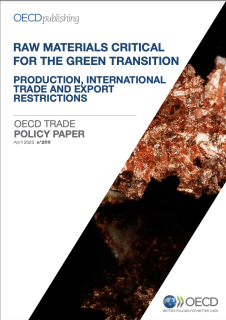
The challenge of achieving net zero CO2 emissions will require a significant scaling up of production and international trade of several raw materials which are critical for transforming the global economy from one dominated by fossil fuels to one led by renewable energy technologies.
Lithium, rare earth elements, chromium, arsenic, cobalt, titanium, selenium and magnesium recorded the largest production volume expansions ranging between 33% (for magnesium) and 208% (for lithium) in the last decade, but even these pale in comparison with the projected four- to sixfold increases in demand projected for the green transition. At the same time, global production of some critical raw materials, such as lead, natural graphite, zinc, precious metal ores and concentrates as well as tin declined over the last decade.
This report presents data on production and trade concentrations, sheds early light on the impact of export restrictions, and discusses possible directions of further work in this area. The evidence presented suggests that export restrictions may be playing a non-trivial role in international markets for critical raw materials, affecting the availability and prices of these materials. OECD countries have been increasingly exposed to the use of export restrictions for critical raw materials.
